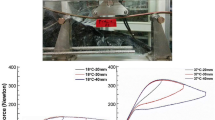Abstract.
The biocompatibility and functionality of a new scoliosis correction device, based on the properties of the shape-memory metal nickel-titanium alloy, were studied. With this device, the shape recovery forces of a shape-memory metal rod are used to achieve a gradual three-dimensional scoliosis correction. In the experimental study the action of the new device was inverted: the device was used to induce a scoliotic curve instead of correcting one. Surgical procedures were performed in six pigs. An originally curved squared rod, in the cold condition, was straightened and fixed to the spine with pedicle screws. Peroperatively, the memory effect of the rod was activated by heating the rod to 50°C by a low-voltage, high-frequency current. After 3 and after 6 months the animals were sacrificed. The first radiographs, obtained immediately after surgery, showed in all animals an induced curve of about 40° Cobb angle – the original curve of the rod. This curve remained constant during the follow-up. The postoperative serum nickel measurements were around the detection limit, and were not significantly higher compared to the preoperative nickel concentration. Macroscopic inspection after 3 and 6 months showed that the device was almost overgrown with newly formed bone. Corrosion and fretting processes were not observed. Histologic examination of the sections of the surrounding tissues and sections of the lung, liver, spleen and kidney showed no evidence of a foreign body response. In view of the initiation of the scoliotic deformation, it is expected that the shape-memory metal based scoliosis correction device also has the capacity to correct a scoliotic curve. Moreover, it is expected that the new device will show good biocompatibility in clinical application. Extensive fatigue testing of the whole system should be performed before clinical trials are initiated.
Similar content being viewed by others
Author information
Authors and Affiliations
Additional information
Electronic Publication
Rights and permissions
About this article
Cite this article
Wever, D., Elstrodt, J., Veldhuizen, A. et al. Scoliosis correction with shape-memory metal: results of an experimental study. Eur Spine J 11, 100–106 (2002). https://doi.org/10.1007/s005860100347
Received:
Revised:
Accepted:
Published:
Issue Date:
DOI: https://doi.org/10.1007/s005860100347




